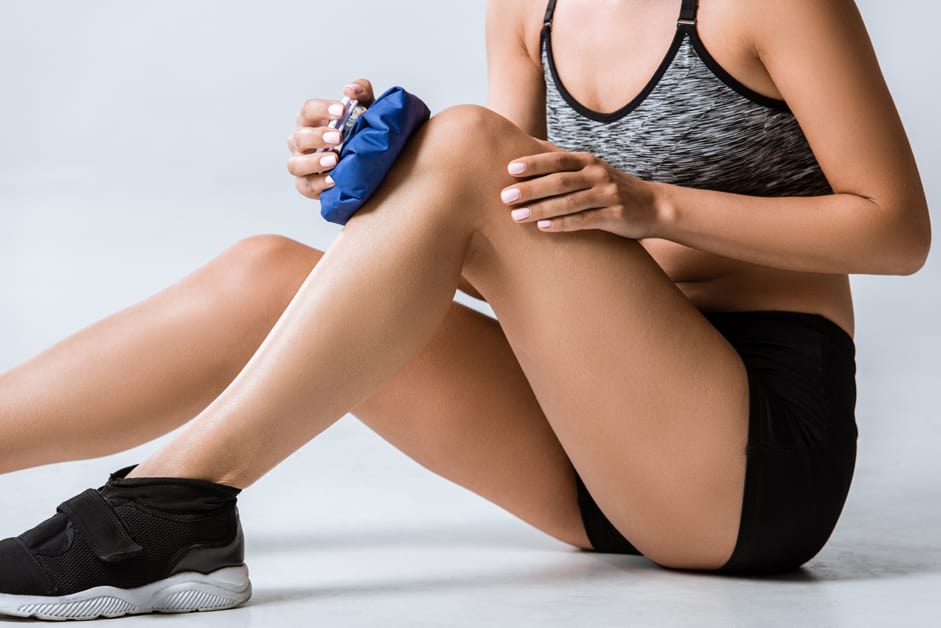Introduction
Heat and cold therapy are both good treatments for knee injury pain. But, which type is right for you? This article will look at the research on the pros and cons of each one. Plus, we’ll tell you the kinds of heat and cold therapies, and when to use them. By understanding the benefits of heat and cold for knee injury pain, you can reduce discomfort and speed up the healing.
Heat Therapy
Heat therapy is an ace for relieving pain. It also eases muscle spasms related to knee injury. It boosts blood flow to the region, shrinking swelling and ache. Heat relaxes tight muscles and improves mobility.
Let us explore the different ways of applying heat for relieving knee injury pain!
- Heat packs
- Hot water bottle
- Warm baths
- Infrared heat therapy
- Paraffin wax baths
Benefits of Heat Therapy
Heat therapy is a type of physical therapy that applies hot and cold to injured areas. It can reduce pain and help muscles regenerate and relax. External heat therapies include hot compresses, heating pads and wraps, hot baths or showers, warm paraffin baths, or infrared saunas. Internal heat therapies include ultrasound or low-level laser treatments.
The benefits of using heat to treat a knee injury are:
- Increasing blood flow
- Relaxing tight muscles
- Reducing inflammation
- Increasing joint flexibility
- Boosting oxygen levels in cells.
Heat is useful before exercise. However, it shouldn’t be used during strenuous activities or after long periods of rest, as the heat may cause more soreness or swelling.
Types of Heat Therapy
Heat therapy is a type of physical therapy. It uses heat to boost circulation, reduce muscle tension and ease pain. Heat helps collagen tissues stretch, improves nerve conduction and quickens metabolic processes. It relaxes muscles and joints, reducing inflammation and discomfort. Heat has many uses in physical rehab, injury prevention, pain relief and performance enhancement.
The type of heat depends on the goal and stage of healing or rehabilitation. Dry heat is typically delivered through heated air from a device that warms the area. This could be a heating pad, hot water bottle or warm towel applied for a while. Moist heat comes from wrapping an area in a moist cloth or applying a warm gel pack. The added moisture helps skin stay supple and gives higher intensity than dry heat. Thermal baths with air and water jets can deliver moist heat to specific body areas. Steam is also used, as it warms and moisturizes. This could be in facial treatments or larger spaces like spas and saunas.
How to Apply Heat Therapy
Heat therapy is a great way to help soothe knee injury pain. It boosts circulation, relaxes tight muscles and ligaments, eases joint stiffness and encourages healing. Heat should be applied cautiously at different levels to prevent overheating or burning. You can use hot packs, electric heating pads, baths or showers.
Here are some tips when applying heat to the knee:
- Use a product that won’t get too hot.
- Give yourself 15 minutes between applications to protect the skin.
- Place a thin cloth between your skin and the hot pack if needed.
- Move the hot pack or heating pad around during treatments.
- Use lower doses of heat for shorter periods for pain relief.
- Don’t apply heat before physical activity or exercise as it may worsen inflammation.
Cold Therapy
Cold therapy is a popular remedy for knee pain due to injury. Its purpose is to minimize inflammation and decrease pain. This therapy includes applying a cold pack or ice wrap directly to the knee’s injured area. The cold constricts blood vessels, decreasing inflammation and soreness. Therefore, it relieves pain.
Cold therapy can be done at home or in physical therapy. Let’s investigate further.
Benefits of Cold Therapy
Cold therapy is a type of physical therapy. An ice pack or cold gel pack is applied for an extended period of time. It numbs pain and reduces inflammation. It can help reduce spasms, muscle tension and swelling. Cold therapy helps stop damage to injured tissue while they heal. It is recommended within 48 hours of an injury. It decreases swelling and inflammation more than heat.
Cold therapy can prevent discomfort such as pain, stinging and pressure. Start with low temperature (below 15°C) and increase gradually over time. Treatments should be limited to 15 minutes with one hour of rest in between. For severe injuries, longer or multiple treatments may be recommended. Breaks between sessions but not more than 30 minutes.
Types of Cold Therapy
Cold therapy, also known as cryotherapy or ice therapy, is the use of cold temperatures to ease pain, swelling and inflammation. It is common to treat sports injuries and medical conditions like arthritis. Cold therapy works by decreasing nerve conduction, reducing inflammation, and shrinking blood vessels to reduce swelling.
There are three main types of cold therapies:
- Cold packs are used for localized cooling and can be stored in the freezer for easy access.
- Cryogenic baths involve using really cold fluids and salts which cool the body rapidly without reaching dangerously high temperatures.
- Mechanical cooling devices have compressors that circulate cold liquid through garments like knee braces or wraps which stay in contact with the area needing treatment.
How to Apply Cold Therapy
When it comes to knee injury pain relief, cold therapy is a simple option. It works by cooling the superficial tissues of the knee and reducing inflammation, which reduces pain.
Cold compresses or ice packs are two common forms of cold therapy. Put a thin cloth barrier, like a lightweight towel, between the cold source and your skin to avoid discomfort or injury from frostbite. A plastic bag filled with frozen vegetables, like peas, can be put against the sore area with a cloth barrier between them and your skin.
For more intense cooling, your doctor may recommend an ice massage tool. Gently roll an ice-filled cylinder over the site of discomfort and apply pressure as necessary.
Be mindful when using either compression or ice massages. They should only be applied for 10-20 minutes at a time and no more than 2 times per day. Prolonged exposure to cold temperatures can cause skin damage and reduce blood flow. Don’t forget to rewarm after applying cold treatments, so you don’t go numb!
Combining Heat and Cold Therapy
Heat and cold therapy together can be a great way to lessen knee pain. Heat boosts mobility, and brings more blood to the area. Cold reduces swelling and pain.
Let’s take a peek at the advantages of combining heat and cold therapy for knee pain relief:
Benefits of Combining Heat and Cold Therapy
Heat and cold therapy together is a natural way to provide targeted pain relief for knee injury. Heat and cold together can increase the range of motion and reduce inflammation. They can give a pain-relieving effect similar to some medicines.
Benefits of combining heat and cold therapy:
- Improved circulation; heat expands the blood vessels, cold contracts them. This helps reduce inflammation and aids healing.
- Less pain; heat and cold together give a soothing feeling, making the area less sensitive and reducing pain.
- Less stiffness; heat and cold stop muscle spasms and improve joint mobility.
- Reduced swelling; cooling treatments constrict blood vessels, reducing swelling and providing comfort from chronic pain like arthritis.
Guidelines for Combining Heat and Cold Therapy
Heat and cold therapies can be a good way to manage knee injuries. Heat is for chronic issues, like muscle strains and pains. Cold is for acute injuries, like sprains and strains. Together, heat and cold can reduce pain, improve joint mobility, and help healing.
When using heat and cold therapies, follow these guidelines:
- Put heat on before cold. This will relax the muscles before cold treatment.
- If using an ice pack, wrap it in a cloth. This will stop frostbite or other harm.
- Limit initial use of either heat or cold to 15 minutes. Don’t go over 30 minutes at once.
- Alternate between heat and cold, if long-term relief is needed.
- Talk to a doctor before starting hot/cold treatments. This will ensure the treatments are safe.
Conclusion
The choice between heat or cold treatment depends on you and your healthcare specialist. Both can help, but should be used alongside bracing, rest, exercise, and medications.
- Heat therapy works best if used regularly, plus with a stretching routine.
- Cold therapy is great post-injury to help with pain and swelling.
Follow your healthcare provider’s instructions and watch your progress for the best result!
Frequently Asked Questions
Q1. How does heat therapy help with knee injury pain relief?
A1. Heat therapy helps to reduce pain, stiffness, and inflammation caused by a knee injury. The heat increases blood flow to the injured area, which helps to relax muscles, reduce stiffness, and promote healing.
Q2. How long should I apply heat or cold therapy to my knee?
A2. Generally, heat should be applied for 10 to 20 minutes at a time and cold should be applied for 15 to 20 minutes at a time. It is important to follow the instructions provided with the heat or cold therapy device and to speak with your doctor if you have any questions.
Q3. Are there any risks associated with using heat or cold therapy for knee injuries?
A3. Yes, there are some risks associated with using heat or cold therapy for knee injuries. It is important to follow the instructions provided with the therapy device and to speak with your doctor if you have any questions. Improper use of a heat or cold therapy device can cause burns or frostbite, so it is important to use caution.





